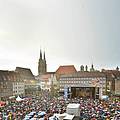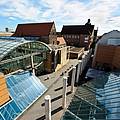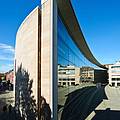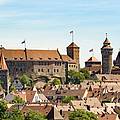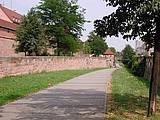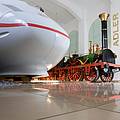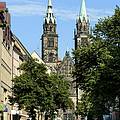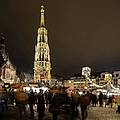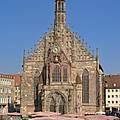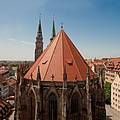
Memorium Nuremberg Trials and Documentation Center
The participants of the Nuremberg Moot Court have the possibility to visit the Memorium Nuremberg Trials and the Documentation Center Nazi Party Rally Grounds for free.
Opening hours of the Memorium Nuremberg Trials:
Monday to Friday (except closing day Tuesday): 9.00 am–6.00 pm
Saturday, Sunday: 10.00 am–6.00 pm
Last admission 5.00 pm
Opening hours of the Documentation Center Nazi Party Rally Grounds:
Monday to Sunday: 10.00 am–6.00 pm
Last admission 5.00 pm
Music festival from 26 July until 28 July 2024
Nuremberg's largest annual music event, the well-known "Bardentreffen" music festival, will take place at the same time as the Nuremberg Moot Court. Participants of the moot court will have the opportunity to enjoy live music from around the world in their free time. There are eight different stages throughout the old part of the city where more than 200,000 visitors are gathering every year to celebrate world music artists and singer-songwriters.
National Germanic Museum
The National Germanic Museum (Germanisches Nationalmuseum) is home to Germany’s largest German art and culture collection. The museum has more than 1.2 million items relating to the region's artistic and cultural history, including historical documents on parchment, a collection of 17,000 seals, and a superb fine arts archive. Other notable highlights include a collection of 300,000 prints and drawings, paintings representing all the major schools, historical musical instruments, a sculpture collection, and a fascinating display of antique toys and dollhouses.
Address: Kartäusergasse 1, 90402 Nuremberg
Neues Museum - State Museum for Art and Design Nuremberg
For lovers of contemporary art and design the “Neues Museum” has a large collection of modern and contemporary art.
The New Museum with its curved glass facade rises over the medieval city walls in the heart of Nuremberg. The handsome museum has received many awards for its striking modern architecture and is a venue for contemporary art and design.
The art collection contains painting, sculpture and photography from 1945 to the present. Its main focus includes Eastern European artists, international works of geometric abstraction and concrete art.
Address: Luitpoldstraße 5, 90402 Nuremberg
Nuremberg Castle (Kaiserburg)
To the north of the old town is the Castle of Nuremberg, an impressive 351-meter-tall structure that dominates the skyline. One of the most important surviving medieval fortresses in Europe, the castle was the residence of all legitimate German kings and emperors from 1050 to 1571.
At the lower end are the old imperial stables built in 1495 (now a youth hostel), and the Pentagonal Tower, dating from 1040. Higher up is the “Kaiserburg”, built in the 11th century (although much altered in later centuries), along with the Sinwell Tower with its wonderful panoramic views. Castle tours take in a number of fine rooms, including the 12th-century chapel and numerous notable works of art.
Address: Auf der Burg 13, 90403 Nuremberg
The Town Walls
Nuremberg has the unique distinction of having preserved most of its circuit of old walls, many dating from the 14th-15th century and later strengthened in the 16th and 17th centuries. Highlights include numerous gates and towers, many of which can be explored. The finest stretch of walls is on the west side of the town, between the massive gates Spittlertor and the former Maxtor, while the best views of the walls, the old town, and the Burg are from the gate Fürther Tor.
The Nuremberg Transport Museum
Just outside the old town walls is the superb Nuremberg Transport Museum (Verkehrsmuseum Nürnberg) with its many displays relating to the country's railroads. Highlights include numerous scale models, as well as a variety of interactive displays. One of the oldest such museums in Europe, its collection also includes royal trains and perfectly restored steam and diesel engines, as well as a working replica of Germany's very first train.
Address: Lessingstraße 6, 90443 Nuremberg
St. Lawrence’s Church (Lorenzkirche)
At “Lorenzer Platz”, the spectacular twin-towered 14th-century Gothic church of St. Lawrence is the city's largest church. One of its many notable features is a large rose window, nine meters in diameter, above the beautiful west doorway. Inside, its many works of art include the Annunciation by sculptor Veit Stoss from 1517 in the choir, its late 15th-century tabernacle, the crucifix on the high altar, the “Krell Altar” with the oldest surviving representation of the town, and the superb stained glass in the choir dating from 1477. Nearby highlights include the Fountain of Virtue from 1589, and the 13th-century tower-like Nassauer Haus.
Hauptmarkt
The “Hauptmarkt” (market square) is home to the aptly named 14th-century "Beautiful Fountain" with its ornate decorations and figures. It is also where you will find the Old Town Hall built in 1616 and notable for its magnificent doorways, dungeons, and torture chamber. Between the two buildings is another famous fountain, the “Gänsemännchen”, built in 1555 and depicting a Franconian peasant carrying two geese, with the water flowing from their beaks. It is at the Hauptmarkt that Nuremberg's famous Christmas Market is held.
Church of Our Lady (Frauenkirche)
The Roman Catholic Gothic “Frauenkirche” (Church of Our Lady) dates back to 1352 and is a must-see when at Nuremberg's Hauptmarkt. Above the porch with its rich sculptural decoration is the “Männleinlaufen”, an old clock with mechanical figures representing the seven Electors pacing round Emperor Charles IV (performances daily at noon). Notable features of the interior are the “Tucher Altar” from 1440 and two handsome monuments by Adam Kraft.
St. Sebaldus Church
Protestant St. Sebaldus Church built from 1225-73, boasts a magnificent Gothic east choir dating from 1379 featuring the Schreyer-Landauer tomb, a masterpiece by Adam Kraft. Inside, on a pillar in the north aisle, is the Madonna in an Aureole dating from 1420, while in the east choir is the famous tomb of St. Sebaldus from 1508, a masterpiece in bronze by Peter Vischer and his sons (a silver sarcophagus from 1397 contains the saint's remains, and Vischer himself is depicted with his leather apron and chisel). Other church highlights include a Crucifixion group by Veit Stoss dating from 1507, and a huge organ with 6,000 pipes.
Albrecht Dürer’s House
Just a stone's throw from Nuremberg Castle is the 15th-century Albrecht Dürer's House where the famous German renaissance artist lived from 1509 until his death in 1528. Now a museum dedicated to Dürer's life and work the building displays copies of some of his creations. Also of note is the nearby Tiergärtner Tor, a perfectly preserved little medieval square. Another famous old home is the late 16th-century “Fembohaus”, the town's best preserved old merchant's house now occupied by the museum “Heimatmuseum” with its domestic interiors and displays relating to the town's history.
Address: Albrecht-Dürer-Straße 39, 90403 Nuremberg
